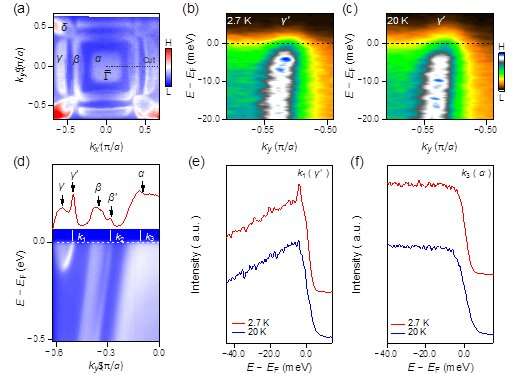Evidence of anomalously large superconducting gap on topological surface state of β-Bi2Pd thin film

Hong Ding's group from the Institute of Physics, Chinese Academy of Science reported the superconducting gap of topological surface state is larger than that of bulk states in β-Bi2Pd thin films using in-situ angle-resolved photoemission spectroscopy and molecular beam epitaxy. Their results provide a new platform to stabilize Majorana zero-energy modes at a higher temperature superconductor that holds a highly enhanced topological superconducting gap.
Majorana bound states have attracted scientists' interests and topological superconductors (TSCs) are predicted to host exotic Majorana states that obey non-Abelian statistics and can be used to implement a topological quantum computer. Recently, experimental scientists provide strong evidences for the existence of Majorana zero-energy mode in vortex cores in single material platforms of Fe(Te,Se) bulk single crystals and similar compounds of iron-based superconductors. The superconducting (SC) gap of topological surface state (ΔTSS) plays a vital role in protecting MZM that a larger ΔTSS leads to a larger energetic separation between MZM and other trivial excitations. β-Bi2Pd, as a candidate of topological superconductor, has some distinct physical characters. A previous scanning tunneling microscopy/spectroscopy experiment observed large zero-bias conductance peaks in the line-cut measurement across its SC vortices and found two SC gaps (Δ1~1.0 meV and Δ2 ~3.3 meV) in the β-Bi2Pd film grown by molecular beam epitaxy (MBE), while only the smaller one (Δ1) compares to the SC gap of β-Bi2Pd bulk single crystal (Δb ~ 0.8 meV, Tc = 5.4 K). In order to understand the puzzle of the anomalously larger SC gap, it is necessary to study the topological superconductivity in momentum space.
In this work, by using in-situ angle-resolved photoemission spectroscopy (ARPES) combined MBE, Hong Ding's group from the Institute of Physics, Chinese Academy of Science grown the 20-UC β-Bi2Pd thin films with tetragonal structure by MBE and studied the superconductivity by in-situ ARPES. The clear topological surface state was observed near fermi energy, which owns anomalously larger superconducting gap (~3.8 meV) measured by temperature dependence experiments. A key question then is the difference of thin film and single crystal. So we measured the band structure of single crystal grown by Youguo Shi's group at the "Dreamline" beamline of the Shanghai Synchrotron Radiation Facility (SSRF) as well. By measuring β-Bi2Pd bulk single crystal as a comparison, we clearly observed the upward-shift of chemical potential in the film. A concomitant increasing of surface weight on the topological surface state was revealed by first principle calculation calculated by Hongming Weng's group, suggesting that the Dirac-fermion-mediated parity mixing may cause this anomalous superconducting enhancement. Their results establish β-Bi2Pd film as a unique case of connate TSCs with a highly enhanced topological superconducting gap.
Their results establish β-Bi2Pd as a candidate of topological superconductor with a highly enhanced topological superconducting gap, which may provide a new platform to stabilize Majorana zero modes at a higher temperature.
More information: Jian-Yu Guan et al, Experimental evidence of anomalously large superconducting gap on topological surface state of β-Bi2Pd film, Science Bulletin (2019). DOI: 10.1016/j.scib.2019.07.019
Provided by Science China Press





















